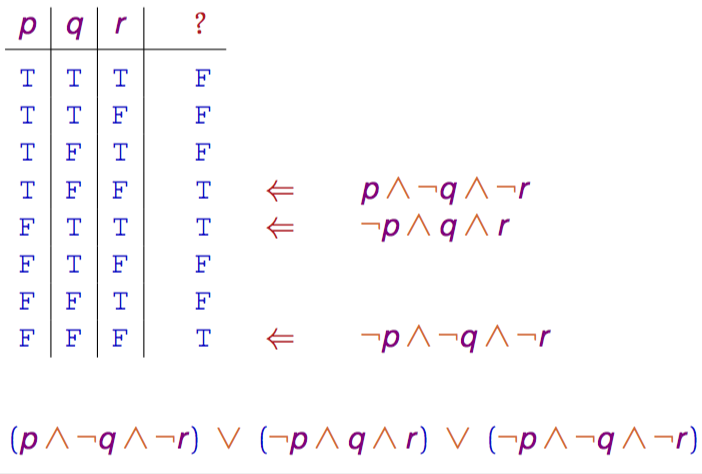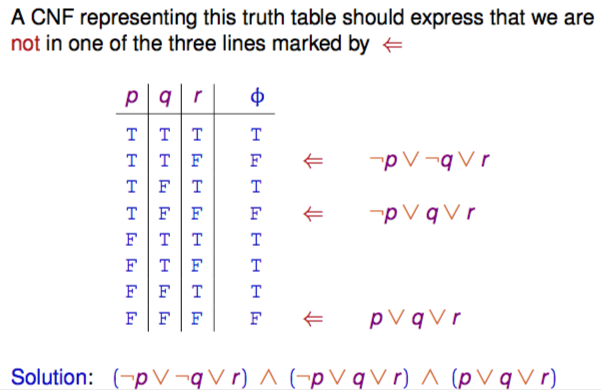Logic & Sets
Table of Contents
Functional completeness
functionally complete — every truth table can be represented by a propositional formula (and vice versa)

Disjunctive normal form (DNF)
this results in a disjunctive normal form (DNF, terms combined with disjunctions)
a DNF is a clause (disjunction of literals)
a DNF is of the form:
Ψ1 ∨ Ψ2 ∨ … ∨ Ψn
where Ψi is conjunctions of literals (p, ¬p, etc.)
a single letter is also a DNF
Conjunctive normal form (CNF)
a conjunctive normal form (CNF) is conjunction Ψ1 ∧ Ψ2 ∧ … ∧ Ψn where Ψi are disjunctions of literals
disjunctions of literals are clauses (DNF), a CNF is a conjunction of clauses

Transform any ϕ to CNF using algorithm in three easy steps
- IMPL-FREE: eliminate implications
ϕ ➝ Ψ ≡ ¬ ϕ ∨ Ψ
- NNF: bring occurrences of ¬ inside, until directly in front of variable (removing double nots)
¬ (ϕ ∧ Ψ) ≡ ¬ ϕ ∨ ¬ Ψ ¬ (ϕ ∨ Ψ) ≡ ¬ ϕ ∧ ¬ Ψ ¬ ¬ ϕ ≡ ϕ
- DISTR: use distributivity law to rearrange conj/disj
ϕ ∨ (Ψ ∧ Χ) ≡ (ϕ ∨ Ψ) ∧ (ϕ ∨ Χ) (ϕ ∧ Ψ) ∨ Χ ≡ (ϕ ∨ Χ) ∧ (Ψ ∨ Χ)
Is a CNF Ψ1 ∧ Ψ2 ∧ … ∧ Ψn a tautology?
Yes, only if in each of clauses Ψi it contains literals p and ¬p for some variable p.
Satisfiability problem
given a propositional formula ϕ, find a valuation that applied to ϕ yields ⊤.
NP-complete — no efficient solution has been found
DPLL (Davis-Putnam-Logemann-Loveland) procedure: checks satisfiability of formula ϕ in CNF.
⊤ — constant true
⊥ — constant false
applies reduction rules:

To check satisfiability of CNF ϕ:
-
Eliminate “unit” clauses
- for clause p of ϕ, replace p in ϕ by ⊤
- for clause ¬ p of ϕ, replace p in ϕ by ⊥
-
Eliminate “pure” propositional variables
- if p only occurs positively in ϕ, replace all p in ϕ by ⊤
- if p only occurs negatively in ϕ, replace all p in ϕ by ⊥
-
If ϕ is ⊤, it is satisfiable
-
If ϕ is ⊥, it is unsatisfiable
-
Choose a p in ϕ:
- replace all p in ϕ by ⊤, apply DPLL
- if outcome is “unsatisfiable, replace all p in ϕ by ⊥ and apply DPLL again